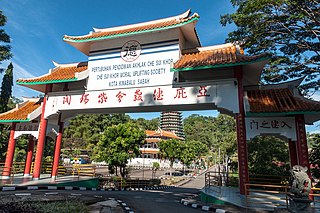 W
WChe Sui Khor Moral Uplifting Society is a Dejiao establishment located in Kota Kinabalu, Sabah, Malaysia. The centre has been opened since 1981.
 W
WThe Cheng Hoon Teng Temple is a Chinese temple practising the Three Doctrinal Systems of Buddhism, Confucianism and Taoism located at No. 25 Jalan Tokong, Malacca City, Malaysia. It is the oldest functioning temple in the country.
 W
WThe Chin Swee Caves Temple is a Chinese temple in Genting Highlands, Pahang, Malaysia. It is situated in the most scenic site of Genting Highlands, on a 28-acre plot of rocky forested land donated by Genting Group founder the late Lim Goh Tong. Located 4,600 feet above sea level, the temple is about 5–10 minutes' drive down from the peak of the mountain. Within the temple is seated a statue of Qingshui, a Buddhist monk who has long been referred to as a deity in Fujian Province, China for his supernatural abilities to summon rain and drive away evil spirits. The temple attracts many local and foreign devotees from Singapore, Taiwan, Vietnam, China, Thailand and Indonesia.
 W
WKampung Cina, is a Chinatown located in Kuala Terengganu, Terengganu, Malaysia. Kampung Cina is located along Jalan Bandar, in Kuala Terengganu city centre at the river mouth of Terengganu River that empties into the South China Sea. Kampung Cina literally means Chinese Village; it is also called Teng Lang Po or KT's Chinatown by local people. It is one of Southeast Asia's early Chinese settlements and contains stately ancestral homes, temples, townhouses, and business establishments. The town is small but has colourful shophouses along both sides of the road that carries traditional flavour.
 W
WChinatown is located at Padungan road, Kuching, Sarawak, Malaysia. The most notable streets in the Chinatown are Main Bazaar and Carpenter Street.
 W
WIn Chinese communities, especially in China, Hong Kong, Malaysia, and Singapore, wedding door games are challenges set up by the bridesmaids for the groom as a ceremonial demonstration of the groom's love for the bride. These games typically take place in the morning of the wedding at the bride's family home, before the groom is allowed to receive the bride in the bride's room. The groom typically receives the help of his groomsmen in completing the tasks.
 W
WThe Gaya Street is a street Sunday market area in Kota Kinabalu, Sabah, Malaysia. It is dubbed as the Chinatown of Sabah due to many Chinese coffee shops and restaurants situated there. In addition with an arch gate that was erected since 2005.
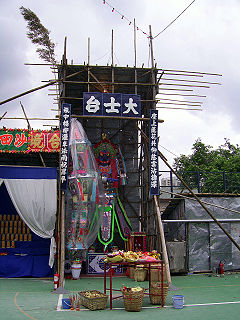 W
WThe Ghost Festival, also known as the Hungry Ghost Festival, Zhongyuan Jie (中元節), Gui Jie (鬼節) or Yulan Festival is a traditional Buddhist and Taoist festival held in certain East Asian countries. According to the Chinese calendar, the Ghost Festival is on the 15th night of the seventh month.
 W
WThe Goddess of Mercy Temple is a Chinese temple in the city of George Town in Penang, Malaysia. Situated at Pitt Street, it was first built in 1728, making it Penang's oldest Taoist temple.
 W
WHainanese chicken rice is a dish of poached chicken and seasoned rice, served with chilli sauce and usually with cucumber garnishes. It was created by immigrants from Hainan in southern China and adapted from the Hainanese dish Wenchang chicken.
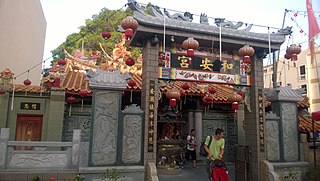 W
WHo Ann Kiong Temple is a Chinese temple situated in Chinatown of Kuala Terengganu, Terengganu, Malaysia. It is the oldest Taoist temple in the state as part of the Chinatown.
 W
WHong San Si Temple is a Chinese temple situated in Carpenter Street of Kuching, Sarawak, Malaysia. It is part of the Kuching Heritage Trail.
 W
WThe Jade Dragon Temple, also known as Yu Lung San Tien En Si, is a Chinese temple located at KM26 of Sibu-Bintulu Road in Sibu, Sarawak, Malaysia. The temple housing the places of worship for Buddhism, Confucianism and Taoism, with the temple complex is considered as the largest not only in Malaysia but believed to be the largest in Southeast Asia as well.
 W
WJade Emperor God Temple or Jade Emperor Pavilion is a Chinese temple located at the foot of Penang Hill at the Air Itam suburb in George Town, Penang. Completed in 1869, it is the only temple in Malaysia to be built specifically for the worship of the Jade Emperor and becomes a focal point for the annual Jade Emperor's Birthday celebrations on the 9th day of Chinese New Year.
 W
WJohor Bahru Old Chinese Temple known as Old Temple by the locals, is a Chinese temple located in Johor Bahru, Johor, Malaysia. Located at Jalan Trus, the temple is flanked by modern skyscrapers. This temple is one of the oldest structures in the city and become the symbol of unity among five Chinese ethnic groups of Teochew, Hoklo (Hokkien), Cantonese, Hakka and Hainanese people.
 W
WThe Jonker Walk is the Chinatown street of Melaka, Malaysia located along Jonker Street.
 W
WKek Look Seah Temple is a Chinese temple located in Taman Happy of Ipoh, Perak, Malaysia. The temple is known for its planchette divination and has a medical room where Chinese medicine is given – which is not common for many Buddhist temple. This persistently making it being mistakenly referred to many people as a Dejiao establishment despite it is a Buddhist temple of Mahāyāna branch.
 W
WThe Malaysian Chinese Association is a uni-racial political party in Malaysia that seeks to represent the Malaysian Chinese ethnicity; it is one of the three major component parties of the coalition party in Malaysia called the Barisan Nasional in Malay, or National Front in English.
 W
WMalaysian Chinese cuisine is derived from the culinary traditions of Chinese Malaysian immigrants and their descendants, who have adapted or modified their culinary traditions under the influence of Malaysian culture as well as immigration patterns of Chinese to Malaysia. Because the vast majority of Chinese Malaysians are descendants of immigrants from southern China, Malaysian Chinese cuisine is predominantly based on an eclectic repertoire of dishes with roots from Fujian, Cantonese, Hakka and Teochew cuisines.
 W
WPeak Nam Toong Temple is a Chinese temple located among housing estate beside Lorong Bunga Bakawali 3 in Kota Kinabalu, Sabah, Malaysia.
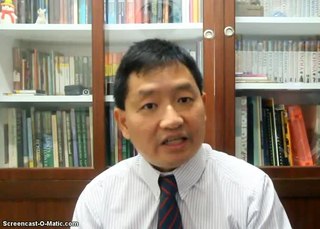 W
WPenang Hokkien is a local variant of Hokkien spoken in Penang, Malaysia. It is the lingua franca among the majority Chinese population in Penang, as well as the neighbouring states of Kedah, Perlis and northern part of Perak. This Chinese dialect is spoken as a mother tongue by up to 63.9% of Penang's Chinese community. It is also spoken by some members of the Penangite Indian and Malay communities.
 W
WThe Poh San Teng Temple (Chinese: 宝山亭; pinyin: Bǎo Shān Tíngis a Chinese temple located at the foot of Bukit China, next to the Malacca Warrior Monument and King's well in Malacca City, Malacca, Malaysia. The temple is dedicated to Tua Pek Kong.
 W
WPu Tuo Si Temple is a Buddhist temple located off Tuaran Road in Kota Kinabalu, Sabah, Malaysia. The temple was built in 1980 with a statue of Guanyin located in the entrance. It is the main Chinese temple for the city. In 2013, the temple received a total of RM115,000 from the federal government to finance its on-going renovation.
 W
WPuu Jih Shih Temple is a Buddhist temple located at the hilltop of Tanah Merah at Sandakan Bay in Sandakan, Sabah, Malaysia. The temple was built in 1987 and officiated by Joseph Pairin Kitingan, the Chief Minister of Sabah at the time. It is the largest Chinese temple for the town and situated around 4 kilometres west of the town centre.
 W
WIn Chinese and other East and Southeast Asian societies, a red envelope, red packet or red pocket is a monetary gift which is given during holidays or special occasions such as weddings, graduation or the birth of a baby.
 W
WSam Sing Kung Temple (also known as the Three Saints Temple) is a Chinese temple in Sandakan, Sabah, Malaysia. Built in 1887, the temple is the third oldest temple in Sandakan, after Goddess of Mercy Temple and Tam Kung Temple. It is part of the Sandakan Heritage Trail.
 W
WSan Ching Tian Temple is a Chinese temple located in a 1.5-acre site bordered by housing area in Krokop 9 Road of Miri, Sarawak, Malaysia, where it is also considered as the largest Taoist temple in Southeast Asia.
 W
WThe Snake Temple is a Chinese temple situated in Bayan Lepas, Southwest Penang Island District, Penang, Malaysia. It was built in 1805 for Chor Soo Kong (祖師公), a Buddhist monk. Devotees from as far away as Singapore, Taiwan and China come to pray in the temple on the monk's birthday.
 W
WThe superstitions of Malaysian Chinese are the traditional beliefs of Chinese Malaysians and Chinese Singaporeans. The ethnic Chinese in both neighbours share a common culture and historical heritage.
 W
WTam Kung Temple is a Chinese temple located at Mile 1.5 of North Road in Sandakan, Sabah, Malaysia. The temple was established in 1894 by Hakka immigrants in Sandakan.
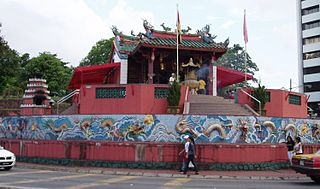 W
WTua Pek Kong Temple is a Chinese temple situated near the waterfront of Kuching, Sarawak, Malaysia, opposite the Chinese History Museum. It is the oldest temple in the city and formed a part of the Kuching Heritage Trail.
 W
WTua Pek Kong Temple in Sibu, Sarawak, Malaysia is the oldest Chinese temple in the town with a 7-storey pagoda with the temple history dates back to 1850s.
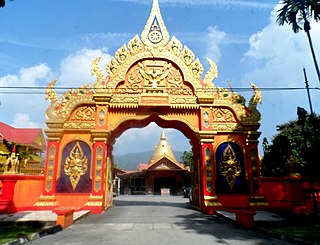 W
WWat Buppharam is a Thai temple in Pulau Tikus suburb of George Town, Penang, Malaysia. Situated at Jalan Perak, the temple is the home to a renowned statue of Buddha, the "Lifting Buddha". The temple became a focal point for the annual Siamese Songkran and Loi Krathong festivals within the city suburb and for the city yearly Buddha Day procession as well the Jathukarm-Ramathep-Ganesha blessing ceremonies.
 W
WWat Chetawan is a Thai temple in Petaling District, Selangor, Malaysia. The temple is situated at Jalan Pantai, off Jalan Gasing in Petaling Jaya. It was built in 1957 and officiated by the late King Bhumibol Adulyadej, the King of Thailand at the time. The temple is also the only Malaysian Siamese temple which has been chosen as the custodian of the Buddha sacred relics for all Malaysian Buddhists that are parts of the ancient relics discovered in Piprahwa, a village in Uttar Pradesh near the border of the Kingdom of Nepal in 1898 which were presented to King Chulalongkorn of Siam by the then British Viceroy of India, Lord Curzon.
 W
WWat Photivihan or Wat Yamu, is a Thai temple in Tumpat District, Kelantan, Malaysia. It is one of 25 temples found in Tumpat and is one of the most popular in the country.
 W
WXiang Lin Si Temple is a Chinese temple located opposite of Cheng Hoon Teng Temple in Jalan Tokong, Malacca City. This double-storey temple follows the Buddhist branch of Mahāyāna Buddhism.